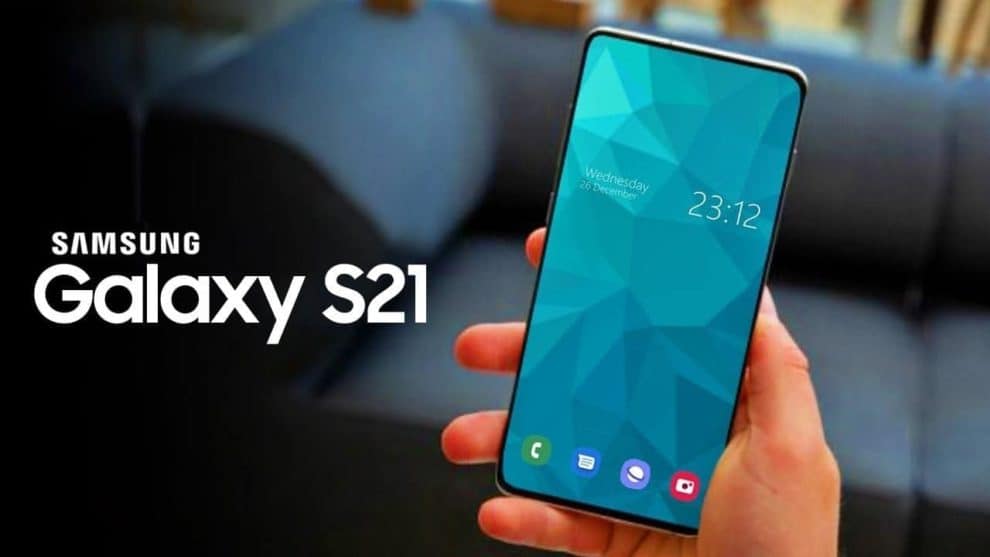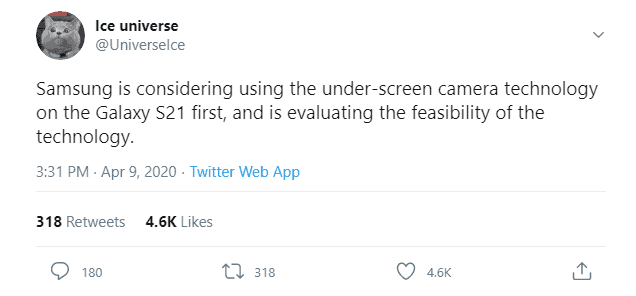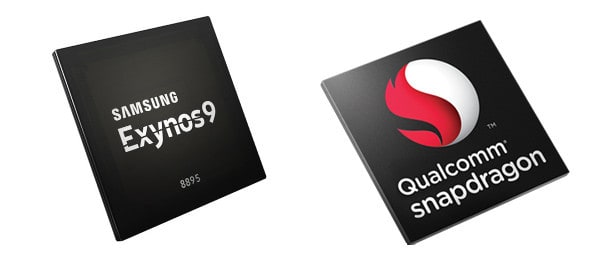The Samsung Galaxy S20 series that debuted earlier this year is a fantastic phone. While some users are impressed by its features, some are already anticipating the next series. As a result, people are already talking and speculating about the next Galaxy S series flagship. According to Twitter tipster Ice Universe, it’s going to be called Samsung Galaxy S21.
Galaxy S21 release date
There is no official confirmation about the Galaxy S21 release date. The Korean electronics heavyweight has typically launched new Galaxy S series phones in February or March. This year’s Galaxy S20 series debuted on February 11 at an Unpacked event in San Francisco and started accepting pre-orders immediately after unveiling.
Samsung is going to hold its next Galaxy Unpacked event on January 14 to unveil the Galaxy S21 series. The Korean company has typically unveiled new Galaxy S handsets in February or March. But it has stepped up efforts to bring the next-gen device sooner to the market.
Sources familiar with the matter told SamMobile that Samsung wants to capitalize on the absence of Chinese giant Huawei. Huawei has found itself in a tight spot due to sanctions imposed by the US government.
According to the ever reliable Twitter tipster Jon Prosser, Samsung will unveil the Galaxy S21 on January 14. There will be three devices – the Galaxy S21, S21+, and the Galaxy S21 Ultra. Prosser has a pretty good track record. He correctly predicted the iPhone 12 launch dates.
The tipster has learned from his sources that Samsung would start taking pre-orders on January 14 itself. Sales would begin a couple of weeks later on January 29, 2021. The S21 would launch in Gray, Pink, Violet, and White colors. The Galaxy S21+ would be available in either Black or Silver colors while the Ultra model would arrive in Black, Silver and Violet options.
What’s more, the upcoming flagship will be manufactured in four different countries – South Korea, Vietnam, Indonesia, and Brazil. Samsung appears to be moving its manufacturing away from China.
Prosser added that the next-gen Galaxy Z Flip will not launch alongside the Galaxy S21 series. Samsung could launch it in the summer of 2021.
Another report from The Elect claims that Samsung would start mass production of the Galaxy S21 series in December. The sale would also start “a month sooner than its predecessors.” This year’s Galaxy S20 series went on sale on March 6th. So, the Galaxy S21 could hit the store shelves in the first half of February 2021.
Galaxy S21 design
Samsung would launch three different models of the Galaxy S21. There will be the standard Galaxy S21, a Galaxy S21+, and a top of the line Galaxy S21 Ultra. According to a new report from tipster Ice Universe, the Galaxy S21 and S21+ will have a flat-screen. The Ultra model is tipped to sport a curved screen.
A render shared by Ice Universe shows off the front display of the Galaxy S21 Ultra. The device features a punch-hole Infinity-O display. The camera hole is placed in the top-center of the screen. It has incredibly slim bezels on all sides and the display is curved on the edges. The volume and power buttons are on the right side of the screen.
Separately, reputed tipster OnLeaks has posted a 360-degree video of the Galaxy S21 Ultra on Voice. The video gives us a detailed look at the Ultra model from all angles. It has an Infinity-O display with curved edges. The bottom of the phone houses a microphone, a USB-C port, and a speaker grille. The SIM tray slot is placed on the top edge. The power button and volume rockers are on the right side.
The Galaxy S21 Ultra has a glossy black finish on the rear panel. It sports four cameras and a flash in a protruding camera housing on the back. The overall design looks stunning.
An exclusive report from 91Mobiles claims that the Galaxy S21 Ultra will be similar to the current S20 Ultra model. Its display size will be marginally reduced to 6.8 inches. The S21 Ultra will have curved display panels while the other two models would sport flat displays. Samsung is also rumored to bump the refresh rate to 144Hz.
According to 91Mobiles, the S21 Ultra would get a 108MP main camera on the back and a huge 40MP selfie camera. Samsung would bring other improvements to differentiate it from the S20 Ultra cameras. Renders shared by 91Mobiles suggest the device will get four cameras on the back, one of which will be a periscope lens.
No charger and headphones in the box
According to a new report coming out of South Korea, the Galaxy S21 series is going to ship without the charger and headphones in the box. Samsung would be following in the footsteps of Apple, which ships the iPhone 12 series without the headphones and charger.
Industry insiders told Korean publication ChosunBiz that Samsung is planning to remove all the in-box accessories except the USB-C cable from the Galaxy S21 box. The company hasn’t taken a final call yet. Removal of the charger and headphones will help boost Samsung’s profit margins. It will also help reduce the environmental impact.
Rumor mills suggest the Galaxy S21 series would have the same price tag as this year’s models. All three models including the Galaxy S21+ and the S21 Ultra would launch without the charger and headphones. Other reports in the past have claimed that Samsung would remove only the headphones, meaning the charger would ship with the phone. But it seems increasingly unlikely.
Ironically, Samsung recently poked fun at Apple for shipping the iPhone 12 series without the bundled EarPods and charger. Users will have to buy the headphones and the charger – both of which are essential – at an additional cost. It’s a neat way to suck more money out of the customers’ wallets.
Galaxy S21 price
The Galaxy S20 series was a dud, to be frank. Of course, the COVID-19 pandemic has hurt its sales in recent months. But the biggest factor behind its low sales volume was the price. The Galaxy S20 series launched with a starting price of $999. It was like Samsung was trying to rob its customers, especially considering most of the competing devices had prices between $600 and $700.
The upcoming Galaxy S21 could be even more expensive than the S20. The main reason will be Qualcomm’s Snapdragon 875 processor. According to a Korean message board, the Snapdragon 875 will be integrated with the X60 5G modem. It added that Xiaomi received a $250 per kit quote from Qualcomm for the Snapdragon 875 Mobile Platform, and $130 for a single chip.
By comparison, the Snapdragon 865 kit costs $150 and the single-chip is available at $80. It means the Snapdragon 875 will be more expensive than the Snapdragon 865. If Samsung decides to use the upcoming 875, it will make the Galaxy S21 series more expensive than its predecessor. The ridiculous cost of Snapdragon 875 is one of the reasons why Google chose to make its own chips for Pixel phones.
Cost options
Of course, the S21 launch is still several months away and Samsung hasn’t officially confirmed anything yet. The Korean company has a few options on the table to bring down the cost. One way is to use chips made by other vendors such as MediaTek. Another option is to use the Snapdragon 875 only in the Plus/Ultra version of Galaxy S21 and have a lower-price chipset in the regular S21.
A third option is to reduce its profit margins to avoid increasing the cost for consumers. A fourth way would be to use the older Snapdragon 865. It is still blazing fast and capable of offering high-end experiences. According to Twitter tipster @MauriQHD, Samsung is internally discussing whether to use the older 865 in the next-gen Galaxy S21.
Camera details
There’s a rumor that Samsung Galaxy S21 will come with a 150MP rear camera. According to it, the S21 will use the same Nano-cell technology as the 108MP ISOCELL Bright HM1 sensor used on Samsung Galaxy S20 Ultra. If this is true, then it’s going to be a huge improvement by Samsung.
The device is unlikely to feature a Time of Flight sensor. The Galaxy Note 20 also launched without a ToF sensor. Samsung is worried that its ‘indirect’ ToF sensor is not as good as Apple’s ‘direct’ sensor.
According to a report by Clien.net, Samsung is testing two different selfie camera prototypes for the Galaxy S21. One prototype camera has a large 1/2-inch sensor with OIS while another prototype has a slightly smaller 1/2.55-inch sensor with OIS. By comparison, the iPhone 11 Pro’s main camera features a 1/2.55-inch sensor.
The bigger selfie camera sensors will allow users to take better photos and videos in low lighting. Larger sensors capture more light. Samsung’s rivals – mainly Huawei, Xiaomi, Oppo, and OnePlus – have upped their camera game and Samsung needs to catch up.
Under-screen camera technology
As with the rumors about Galaxy S21, we have our first one from the tweeter influencer Ice Universe. The speculation tipped that Samsung plans to use the under-screen camera technology first on the Galaxy S21, with the expectation of launching it by next year.
Since Samsung are fond of debuting their new and major camera developments first on the Galaxy S series, it would be interesting if S21 can come with this amazing camera technology.
Supply chain rumors suggest the under-screen camera technology has reached close to maturity. It would still take Samsung some time to refine it. So, there is little chance of the under-screen camera appearing in the Galaxy Note 20 series. But the next year’s Galaxy S21 could be Samsung’s first flagship to boast the under-screen camera technology.
However, it’s not always easy to come up and incorporate technologies like that in smartphones. That’s because it first requires planning and evaluating the feasibility of the technology. Apart from that, one other issue that needs consideration is insufficient light reaching the sensor. And that requires matching the pixel density with areas where the sensor is placed with the rest of the screen.
Of course, that isn’t a big issue if the company has plans to incorporate the camera technology in its next Galaxy S series. Samsung is one of South Korean’s chaebols and one of the leading smartphone manufacturers in the world. So, we should be expecting the under-screen camera technology pretty soon.
Samsung Display is the global leader in the OLED display technology. It is rumored to have been testing under-display camera technology for a long time. We wouldn’t be surprised if Samsung Display manages to introduce the under-screen camera tech with the Galaxy S21 next year.
A new display supplier for Galaxy S21? No
Last month, there were speculations that Samsung Electronics had approached China’s BOE to source OLED panels for the Galaxy S21. Samsung is the world’s largest maker of OLED displays. But BOE’s screens would have been significantly cheaper, reducing the cost of the Galaxy S21 production. The Korean company was testing BOE’s OLED panels.
Twitter tipster Ice Universe reports that Samsung has decided not to use BOE’s OLED displays in the Galaxy S21 series. Why? Because BOE panels failed in the very first stage of Samsung’s testing process. There is a reason why cheap is synonymous with poor quality. Last month, the Display Supply Chain Consultants had reported that BOE could supply 6.67-inch panels to Samsung. But that’s not going to happen now.
Among other things, the Galaxy S21 will use Qualcomm’s new in-display fingerprint sensor, which is 17 times bigger than the technology in the Galaxy S20 series. It will also be faster and more reliable.
BOE has also expressed interest in securing OLED panel orders from Apple for the upcoming iPhone 12. But it failed to meet Apple’s quality standards. Notably, BOE currently supplies TFT LCD panels for Samsung’s Galaxy Book S.
An innovative 16GB RAM technology
Samsung has unveiled a breakthrough technology for RAM in smartphones. And the technology could find a way into the Galaxy S21. The Korean company said in a press release that it has started mass production of a 10nm 16GB LPDDR5 RAM module. The RAM is built using an innovative Extreme Ultraviolet technology.
The new technology makes the LPDDR5 RAM modules 16% faster than the current 12GB RAM chips. It also makes components 30% slimmer than the LPDDR5 modules used in current flagship smartphones. It manages to pack an impressive 16GB RAM in a device as small as smartphones. The extra RAM will be particularly useful to people who multitask on their phones or play demanding games.
Samsung said in its statement that the new RAM chips are so fast that they can transfer up to 51GB of data per second. Considering it has entered mass production, it will highly likely make it to the upcoming Galaxy S21. Samsung could also supply it to other smartphone vendors.
Next-gen Snapdragon and Exynos chips
Snapdragon chip
Apart from the under-screen camera, the rumor has it that Galaxy S21 will use Qualcomm’s Snapdragon 875 chipset. Snapdragon is a suite of systems on chip semiconductor products for mobile devices. Just like the 865, Snapdragon 875 will also support 5G and advanced gaming and graphics.
It will be based on TMSC’s 5nm technology, meaning that it’ll feature over 171 million transistors per square millimeter. An advantage of that is that users will be able to enjoy improved device performance and efficiency.
Folks at 91Mobiles have learned from supply chain sources that the Snapdragon 875 will be equipped with Kryo 685 cores. There will likely be at least eight such cores. The Snapdragon 875 unveiling would take place towards the end of this year.
The Snapdragon 875 will integrate the next-gen X60 5G modem within the chip. Notably, Samsung will be responsible for manufacturing the X60 5G modem for Qualcomm, though the Snapdragon 875 will be fabricated by Taiwan-based TSMC.
Qualcomm’s upcoming Snapdragon processor will have a new GPU called Adreno 660, which would have more than 1250 GFLOPS. Sources told 91Mobiles that the Snapdragon will also include an Adreno 665 vector processing unit, Adreno 1095 data processing unit, Spectra 580 image signal processor, and support for quad-channel PoP high-speed LPDDR5 RAM.
Exynos chip
Samsung’s Exynos chips haven’t been able to match the performance of Qualcomm’s Snapdragon chips. The Korean company is considering a refresh to its Exynos 990 chipset. However, Samsung has joined hands with AMD to step up the game, and the Galaxy S21 could be the first device to benefit from the partnership.
A new Geekbench listing indicates that the Galaxy S21 series will run Samsung’s Exynos 2100 chipset. Unconfirmed reports in the past claimed that the device will run an Exynos 1000 processor. Notably, the Exynos 1000 chipset (4250 score) has outperformed the Exynos 2100 (3060 score) on Geekbench.
However, Samsung has partnered with AMD for GPU to ensure that the Exynos-powered Galaxy S21 delivers the same level of graphics performance as the Snapdragon 875-powered version. The new Exynos will be using AMD’s custom RDNA GPU technology instead of Mali GPU. The AMD graphics processor will take GPU performance to a whole new level. AMD’s chips are insanely popular among gaming enthusiasts.
Battery capacity
Just days after the Galaxy Note 20 series launch, the rumor mill has spilled the beans on the upcoming Galaxy S21 flagship.
According to a Weibo post, the Galaxy S21 series recently made its appearance on China’s 3C certification site. The devices spotted on 3C include the Galaxy S21, Galaxy S21+, Galaxy S20 Ultra.
The Galaxy S21 with model number SM-G9910 features a 3,880mAh battery. Samsung will likely market it as 4,000mAh. It supports 25W of fast charging. The larger Galaxy S21+ with model number SM-G9960 features a 4,660mAh battery.
The top of the line Galaxy S21 Ultra appeared with 4,800mAh battery, which Samsung could market as 5,000mAh. Its model number is SM-G9980. According to the Weibo post, all three models would support 25W fast charging.
China-based Ningde Amperex Technology will manufacture the S21 Ultra battery. However, having the same capacity doesn’t mean the battery life will also be the same. It would vary depending on energy efficiency, screen size, and other factors.
For now, these rumors and speculations should be taken with a pinch of salt. The device is about a year away, and a lot could change between now and then.
This post was updated on 04 November 2020 with the latest information.



